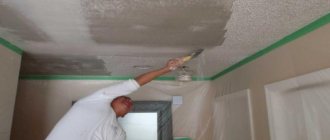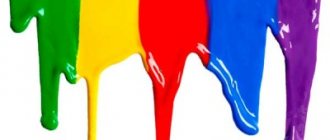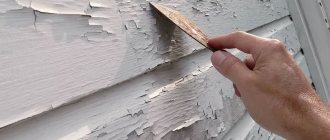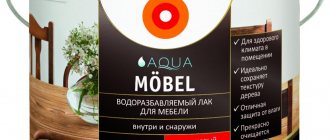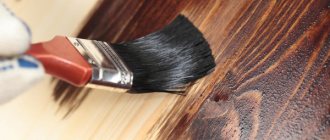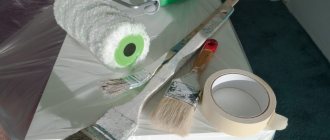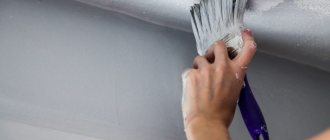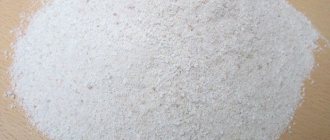This article discusses almost all current methods of removing water-based paint from the ceiling. After studying the recommendations presented, you can confidently begin carrying out repair work without fear that you will encounter unforeseen problems.
1. Preparatory work 2. Selection of tools 3. Removing paint using chemicals 4. Using a mechanical method to clean the ceiling from paint 5. Thermal method of cleaning the ceiling 6. Removing paint using paste or wallpaper glue 7. Removing paint with water 8. Final stage
At the same time, the relevance of this topic is constantly growing, since the presented category of paints is one of the most popular for renovation in a house, apartment or office.
In this case, the positive characteristics of water-based paint are a serious obstacle to completing the task (preparing the ceiling for painting). At the same time, you cannot leave the old layer of paint, this can lead to unpleasant consequences: you will not get the desired color of the ceiling, bubbles, cracks, etc. may form.
Preparatory work
Before you begin removing paint from the ceiling, you need to carefully prepare the room.
Be sure to remove from the room all things that could be damaged during the renovation process. Everything that remains in the room should be covered with high-quality plastic film.
If you do not plan to paint/repair the floor, then prepare plastic film, old newspapers, magazines and other paper to protect it.
Don't forget an important detail: the legs of the stepladder you will use to prepare and paint the ceiling can cause serious damage to the floor surface. Be sure to substitute something more reliable than newspaper and film.
Depending on how you will clean the ceiling from water-based paint, you will need different tools, but in any case, to protect your eyes, face, mouth and nose, be sure to use:
- respirator or gauze bandage;
- construction glasses;
- headdress;
- gloves;
- handkerchief.
Be sure to check the condition of your stepladder and think about how and where best to place the tools so that you don’t have to go up/down the stairs every time you need something.
What should you know before you start cleaning?
Before choosing a method for removing water-based emulsion, you need to determine its type. Depending on the main component, the paint contains:
Acrylic - includes acrylic resins that harden after drying. It is resistant to water and various detergents if it contains latex. It's not that easy to remove, but alcohol and solvents will do the job.- Silicone - in addition to resin, it contains an antiseptic. The coating is impervious to moisture and steam, so it is usually used in bathrooms and kitchens. Special industrial removers remove such paint well.
- Silicate - an aqueous suspension with the inclusion of liquid glass. It is more suitable for finishing industrial premises. Its service life is about 20 years. It is easily washed off with plain water.
- Mineral - its basis is slaked lime or cement. The cheapest and most short-lived material that is not used for final repairs.
- Polyvinyl acetate (PVA) - due to its reduced resistance to moisture, it is used exclusively for interior decoration. This type of coating can be easily removed with a soap solution.
Hence the conclusion that acrylic, silicone and PVA paints are mainly used in residential premises.
Selecting Tools
If you don’t delve into the details of each method of cleaning the ceiling, you can make a list of the tools that are most often used to perform this work:
- 1.Step ladder
- 2. Wire brush
- 3. Roller
- 4. Water container
- 5. Spatula (preferably several, different sizes)
- 6. Drill with attachments for ceiling sanding
- 7. Long handle for roller
Pay attention again! The presented list of necessary things for removing paint from the ceiling is basic; in some cases, the necessary tools may be added or some of them may not be used at all.
Process description
Wetting the ceiling surface with a mop
Regular (non-waterproof) paint can be easily removed from the ceiling if it is soaked first. This was mentioned in the article How to wash whitewash from the ceiling: surface preparation.
You can do this in the following ways:
- Pour water (preferably warm) into a basin or other suitable container. Prepare a foam roller with a long handle. Wet the roller in the basin and pass it along the ceiling. After wetting the surface, you should wait 10 minutes for the paint to become saturated with water, then begin removing.
- Wetting the surface can be done using a conventional water sprayer,
Advice! You should not wet the entire surface of the ceiling with water at once, otherwise it will have time to dry before it gets its turn. It is more convenient to treat the ceiling in small sections.
Soaked paint can be easily removed with a metal spatula. If the paint does not work in some area, you should additionally wet the paint layer. And if this does not help, then clean the ceiling with a wire brush.
Removing paint using chemicals
The presented method is based on the use of special chemicals.
- 1. To do this, you need to prepare a solution following the manufacturer's instructions.
- 2. Then, using a brush, apply it to the ceiling and wait for it to take effect.
- 3. At the last stage, you need to remove the old paint with a spatula.
This method allows you to very quickly remove paint from the ceiling. But it belongs to the category of highly toxic methods, the solution has a sharp, unpleasant odor, and contact of chemicals with the skin can cause burns.
If there are several layers of paint on the ceiling in your room, you will have to remove them in stages (first the first layer, then the second, etc.).
Specialists who know how to remove water-based paint from a ceiling also do not like this method because the chemical solution cannot simply be poured down the drain or in a secluded place on the street.
The use of toxic substances requires compliance with safety regulations. Be sure to use a respirator, gloves and goggles, and also take care to protect exposed areas of the body. This method can only be used in rooms that are well ventilated.
Methods for washing off acrylic and latex paints
By the name of these painting compositions it is clear which polymer is included in its composition. Both types of water-based paint are washed off with a soap solution containing special chemicals that can attack acrylic or dissolve latex; you can also use a special solvent or remove it mechanically.
Washing off water-based acrylic paint
The layer of acrylic paint on the ceiling is highly resistant to wear and water, and also adheres well to many building materials. It is quite difficult to wash it off with plain water. The paint will soak faster if medical iodine is diluted in water. One bottle of iodine is enough for a bucket of liquid. First, you will need to rub the ceiling plane with a stiff metal brush, trying to create more grooves. After this, the surface will need to be moistened with hot water until the water penetrates the scratches and saturates the paint layer. Then you should ensure that there is a draft in the room so that the wet water emulsion swells and is easier to clean. The swollen paint is cleaned off with a metal spatula. To prevent it from drying out too quickly, work is carried out in stages (in small sections), gradually moving over the entire surface.
It is much easier to remove the old coating if you prepare a thick soap mixture into which you add a portion of salicylic acid, ethyl alcohol or regular vodka. Hot soap foam is applied to the ceiling surface using a brush or roller for 20 - 25 minutes. During this time, the paint coating becomes soft and can be instantly cleaned off with a spatula. The tool must be held level so as not to damage the plaster layer.
Washing off latex-based water-based paint
You can wash the ceiling of latex water-based paint with a thick soap solution with the addition of an organochlorine substance (dichloroethane), medical chloroform, R-4 solvent or white spirit. These solvents emit toxic fumes, so the room must be well ventilated and personal protective equipment must be used when working:
- respirator;
- gloves;
- protective glasses.
To remove the latex coating, part of the surface to be treated is thickly moistened with a soap composition with the selected additive and left for 15 - 20 minutes. When the layer softens, it is cleaned off with a hard sponge or spatula.
Using a mechanical method to clean the ceiling from paint
Despite the fact that the mechanical method of cleaning the ceiling requires more time than the previous method, it is liked by many specialists working in this industry. They are attracted by the safety, lack of toxic substances and low cost of cleaning the ceiling mechanically.
In this case, the ceiling is cleaned using water and a spatula. Notches are made on the surface of the ceiling, it is sprayed with water, and then the paint is peeled off. You can use an ax or other tools convenient for such work.
To increase the effectiveness of the presented method of cleaning the ceiling from paint, you can use a grinder with a wide circle or a drill with a special attachment. In this case, the work time will be significantly reduced, but there will be a lot of dust, so do not forget to wear goggles and a respirator.
Is it possible to paint over the old layer?
Very often people are too lazy to remove old coverings from walls, floors or ceilings. It is impossible to say exactly how many layers can be applied. Typically, a plastered ceiling is covered with 1-2 layers of paint, which is updated every few years. In appearance it seems that the layer is thin and nothing will happen if you apply a couple more. After some time, the paint begins to crack and bubble - the coating becomes, to put it mildly, imperfect. Removing that much paint will take a lot of time and effort.
It is better to remove old layers during each repair, and this applies to both oil paint and water-based paint. If you have to suffer with the first one, the second one is washed off quickly even with water; cleaning does not take a long time. In cases where there is no desire to do this, it is recommended to at least thoroughly sand the ceiling to remove all detachments.
Water-based paint is an excellent solution for painting walls or ceilings. It is matte, dries quickly, has no unpleasant odor and holds up well. Many people prefer not to remove the old coating before applying new layers, but in vain. This is what influences the final result. With the help of water and newspapers it is easy to get rid of unnecessary coating in a matter of hours.
Thermal method of cleaning the ceiling
If you have a powerful hair dryer (preferably from reputable manufacturers), use it to remove water-based paint from the ceiling surface. To do this, you need to heat the old layer of paint well and then remove it with a spatula.
Important point! It is not allowed to use the thermal cleaning method in places where electrical wiring passes or near plastic materials (decorative elements). This is due to the fact that a hair dryer creates a very high temperature, which is quite enough to melt the wire winding or plastic.
When old paint is heated, a pungent, unpleasant odor is released, so be sure to wear a respirator and ensure good ventilation in the room.
As for the financial side of the issue, unlike the chemical method, which involves the purchase of expensive reagents, in this case you do not have to spend a lot of money, provided that you have all the necessary tools.
Mechanical method
You can remove waterproof paint using a drill with a sanding attachment. The disadvantage of this method is the large amount of dust generated. A protective film on the floor and furniture and a damp cloth at the entrance will help partially correct the situation.
To work you will need:
- ladder;
- respirator and glasses;
- drill with grinding attachment.
A nozzle with metal bristles will help you quickly clean thick layers of paint in places where it could not be washed off.
Removing paint using paste or wallpaper glue
Many experienced craftsmen, despite the fact that they know how to remove water-based paint from the ceiling using all of the above methods, in practice use only wallpaper glue or paste for these purposes.
This method requires a minimum set of materials and tools:
- glue;
- newspapers magazines;
- sandpaper;
- ladder.
The presented method is based on the fact that the paper sticks so tightly to the old layer of paint that it can only be peeled off together with it.
The main thing is to carefully lay the newspapers and glue them well so that there are no sagging, air bubbles, etc.
Cleaning the ceiling from paint using this method has one drawback - you need to wait quite a long time for the glue to dry.
Sometimes this takes several days. But if you consider that this method requires almost no financial investment (the main cost is the purchase of glue), then you can ignore this small drawback.
How to remove fresh stains from different types of fabrics
After repairs, work clothes look dirty. Water-based paint leaves streaks and stains. You must be able to remove stains using proven methods.
We recommend: Drain hose extension for washing machine: how to install
Denim
It is more difficult to remove bright stripes from thick fabric. You can try wiping the stains with a solvent such as white spirit or acetone. Then the item is placed in the washing machine, rinsing thoroughly at the end.
Natural
Satin and cotton robes and cotton shirts are cleaned with gasoline, placing paper under the material. Solvents also help get rid of contaminants. At the end, be sure to wash things in soapy water.
Synthetics
It’s easy to ruin an item made of polyester or other synthetic material if you use solvents to remove stains. Here it is better to use vegetable oil. Moisten a cotton pad with oil and wipe away dirt. You need to put paper under the fabric. It will take a long time to wipe off the dirt. When the goal has been reached, the item is washed in a soapy solution.
Removing paint with water
Even before starting the work in question, you need to check which category the old paint on your ceiling belongs to.
To do this, just wet a small area with water, and after 10-20 minutes try how the paint will be removed in this place.
If the old paint is not waterproof, you will not have to buy expensive reagents, breathe heated fumes or construction dust, etc. In this case, you must proceed according to the following algorithm:
- 1. Wet part of the ceiling well with water and wait until it is absorbed.
- 2. Using a spatula, remove the old, wet layer of paint.
- 3. Clean the area using sandpaper.
Attentive readers will most likely have noticed that only a certain area needs to be moistened with water, and not the entire ceiling at once. This is due to the fact that while you are removing paint in one place, the water in another will already dry and you will have to do everything from the beginning.
We wash away the silicone paint
This composition is usually used to paint ceilings in rooms with high humidity levels. It will not be possible to remove it from the ceiling with water or soapy water. To destroy silicone-based water-based compositions, special chemicals (removers) are produced.
Types of water-based paint solvents
We can easily wash off the layer of silicate paint using a special active agent:
- DOCKER S4 remover does not contain acid and has a gel-like viscous structure that is convenient to apply to the ceiling. The solvent acts instantly, penetrating deeply into the coating. After just 3 – 10 minutes, the paint layer softens, which then begins to bubble and is easy to clean.
- ELKON S remover is an inorganic solvent that actively removes paint from any base and has thixotropic properties. The reaction takes place within 1 – 10 minutes. The detergent is applied to layers of water-based emulsion, which quickly soften and are cleaned using a spatula, a stiff brush or a wooden scraper. This product can remove two or three layers of old coating at a time.
- APS-A77 remover effectively softens paint coatings on any building materials. After some time, the layer cracks and swells, which makes it possible to quickly remove it from the base plane. The chemical acts on the surface for 2 to 30 minutes. How long it takes for the product to break down depends on the thickness of the finishing layer.
- FAIL-4 wash. This is a universal viscous liquid designed to remove all types of paint compounds. Action time 3 – 15 minutes. It has excellent thixotropy and anti-corrosion properties to the material of the main structure, and can be diluted with water.
Chemical paint removal procedure
The wash is used to cover the prepared surface, from which dirt, dust has been previously removed and furrows have been scratched with a metal brush.
You can remove water-based silicone paint from the ceiling by applying detergent in two ways:
- Cover the surface to be treated with a hand tool: brush, roller or pouring metal. The gelatinous mass of the remover is applied to a small part of the surface and after a few minutes it is wiped with solvent P-646 or P-5, after which the paint can be easily removed with a scraper made of metal or wood. Next, the same procedure is performed on the rest of the base plane.
- Application using an airless spraying machine (used only for FEIL-4 wash). You can use a spray gun by pouring wash diluted with water into its working container to approximately 10–20% of the tool’s volume. The wash is applied in a stream onto the surface to be treated and left for 3 to 15 minutes. The duration of action varies depending on the strength and thickness of the formation.
After removing the paint using a stripper, the ceiling surface must be washed with aqueous solutions with the addition of detergents.
Work only with the use of protective equipment (working clothing, rubber aprons, gloves and safety glasses) in a well-ventilated room.
The final stage
Regardless of the chosen method of cleaning the ceiling from old paint, after completing this procedure, you need to take sandpaper, a drill or a grinder and carefully walk through all the places where the paint remains. Then, you need to thoroughly wash the ceiling using a sponge and water.
Note! Subsequent work (new painting) can be carried out only after the ceiling has dried (preferably naturally).
After a detailed study of the topic of how to remove water-based paint from a ceiling, almost every adult reader will be able to carry out this work independently.
The main thing is to choose the right one of the listed methods for cleaning ceilings so that it best suits your situation, and always follow safety rules.
In what cases should you wash off the water-based emulsion?
If the old coating holds up perfectly, you can thoroughly rinse the surface with water, wait until it dries completely and pre-coat it with an acrylic primer. After this, you can safely paint with a new water-based emulsion.
But there are conditions when it is necessary to remove water-based paint:
- A major renovation is planned;
- The old paint was swollen and blistered;
- The new coating will be of a different type;
- The selected shade is much lighter than the previous color.
This is interesting: if you try to apply a lighter shade of paint, even in several layers, the shade of the old water-based emulsion will still show through the new paint.
